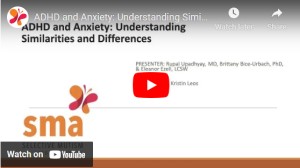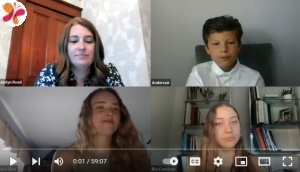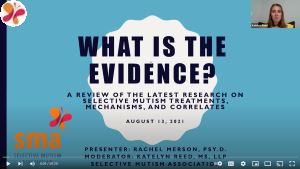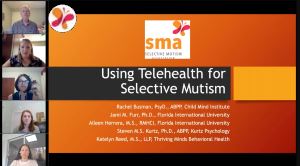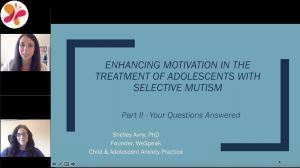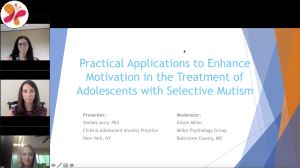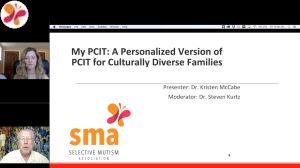Presented by Brittany Bice-Urbach, Ph.D., Eleanor Ezell, LCSW & Rupal Upadhyay, MD, FAAPRecorded: Wednesday, July 17, 2024. This webinar is geared toward parents, treating professionals, educators, and caregivers. This presentation… Continue reading Webinar ADHD and Anxiety: UnderstandingSimilarities and Differences
Resources Categories: Professionals
Hear Our Voices Panel
Moderator: Katelyn Reed, MS, LLP Recorded: June 2, 2022 This webinar is geared toward treating professionals, school professionals, parents, caregivers, and individuals with SM! Join individuals who have overcome Selective… Continue reading Hear Our Voices Panel
What is the Evidence? A Review of the Latest Research on Selective Mutism Treatments, Mechanisms, and Correlates
Presented by Rachel Merson, Psy.D Recorded August 13, 2021 This webinar is geared toward treating professionals. Description: For treating professionals, it can sometimes be challenging to stay on top of… Continue reading What is the Evidence? A Review of the Latest Research on Selective Mutism Treatments, Mechanisms, and Correlates
Webinar: Beyond Talking – Targeting Exposures for the Bathroom and Eating
Using the bathroom and eating are two areas that many children with SM struggle with. While for some children, the anxiety has to do with the talking related to these activities (e.g. asking to use the bathroom or asking for help opening food items), many children struggle with the activities themselves. Join Rachel Busman and Eleanor Ezell in a discussion
Webinar: Differentiating Exposures at School- Meaningful Goals for Each Stage of Your Child’s Journey
Emily Doll and Rachel Busman talk about speaking at school and how parents and teachers can choose the right path based on where the child is at in their speaking goals. The speakers will specifically discuss what strategies to use 1) when the child is not yet verbal at all, 2) when the child is starting to speak, and
Webinar: De-Stressing the Season: Tips and Strategies for Navigating Bravery During the Holidays
Keeping children’s anxiety at bay can be challenging while navigating these uncertain times of COVID-19. Join Dr. Rachel Busman and Dr. Jami Furr as they share tips for mitigating your child’s and teen’s anxiety.
Webinar: Using Telehealth for Selective Mutism
Join Dr. Rachel Busman, Dr. Jami Furr, Dr. Steven Kurtz, Aileen Herrera and Katelyn Reed as they discuss using telehealth while treating selective mutism. The panel covers what platforms they are using and why, as well as the different methods to best continue working with your clients. They discuss typical barriers to practicing online, managing parents’ expectations and the importance of self-care.
Webinar: Your Questions Answered: Enhancing Motivation in the Treatment of Adolescents with Selective Mutism – Part II
During “Enhancing Motivation in the Treatment of Adolescents with SM – Part I”, Dr. Shelley Avny presented the “whys” and “hows” of enhancing treatment motivation and engagement among adolescents with Selective Mutism. Part II is broken down into several themes, guided by audience questions from Part I. These themes include: the virtual era (school and therapy), parent involvement (reducing enabling and using supportive techniques), scaffolding and scaling back exposures, medication, and rewards/contingencies.
Webinar: Practical Applications to Enhance Motivation in the Treatment of Adolescents with Selective Mutism
There is a subset of the population whose selective mutism persists into adolescence. Developmental factors in teenagers can hinder motivation. Therefore, strategies have been recommended to help motivate and engage adolescents in treatment.
Webinar: My PCIT: A Personalized Version of PCIT for Culturally Diverse Families
This webinar will highlight a program developed to personalize Parent-Child Interaction Therapy designed to be responsive to particular parent explanatory models. Personalization is based on the assessment of modifiable, culturally-influenced PEM targets prior to the start of PCIT and the provision of corresponding tools to therapists to increase the cultural congruence of the intervention with relevant parent explanatory models. This type of method provides flexibility in the application of adaptations, tailored to the assessment of culturally-influenced constructs across racial/ethnic groups.
